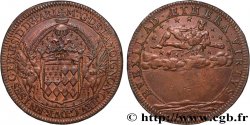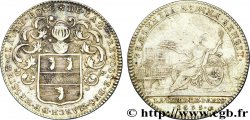fjt_885986 - ILE DE FRANCE - TOWNS AND GENTRY Clément-Charles-François de L'Averdy ou LAVERDY, marquis de Gambais, refrappe postérieure n.d.
90.00 €
Количество
Добавить в корзину

Тип Clément-Charles-François de L'Averdy ou LAVERDY, marquis de Gambais, refrappe postérieure
Дата: n.d.
Монетный двор / Город: s.l.
Металл: copper
Диаметр: 31,5 mm
Ориентация осей монеты: 12 h.
Вес: 16,07 g.
Век: lisse
Пуансон: MAIN Cuivre
Редкость: R2
Ссылки в каталоге: :
Лицевая сторона
Аверс: легенда: ANÉPIGRAPHE.
Аверс: описание: Armes de Clément de L’Averdy.
Обратная сторона
Реверс: легенда: CL . CH . FR . / DE LAVERDY . / MINISTRE D’ETAT . / CONTROLEUR GENERAL / DES FINANCES.
Комментарий
Clément de Laverdy (ou de L'Averdy, 1723-1793), jurisconsulte, conseiller au parlement de Paris, successeur de Bertin au contrôle général des Finances (1763-1768), représente un courant libéral issu de Montesquieu. Il autorise la libre circulation des grains et leur exportation en 1764 ; il tente une réforme d'administration provinciale et municipale en favorisant les tribunaux et en réduisant la tutelle des intendants ; il brise les oligarchies municipales et supprime les offices vénaux afin d'assurer une meilleure gestion des finances locales et d'uniformiser l'administration du royaume (1764-1765). Il satisfait les propriétaires, les éléments supérieurs de l'artisanat qui participent à la vie des villes de plus de deux mille habitants, mais il mécontente les privilégiés et les bourgeois.
Ses mesures sont difficiles à appliquer en Flandre, Bourgogne, Artois, Bretagne, et elles sont abrogées par son successeur, Terray, en 1771. Laverdy se retire sur ses terres près de Montfort-l'Amaury et se consacre au plaisir d'écrire.
Victime de la Révolution, accusé d'avoir partie liée avec les spéculateurs et d'avoir fait jeter du blé dans les étangs pour accroître la disette, il est guillotiné
Il joua un rôle important dans le procès de la Compagnie de Jésus, en raison de ses opinions jansénistes.
Lhôtel de Laverdy subsiste en partie, intégré aux ateliers de la Monnaie de Paris, du côté de l’impasse de Conti, Clément François de Laverdy y habita jusqu’à la Révolution.
Ce bâtiment fut rattaché à la Monnaie de Paris le 20 décembre 1795 pour abriter les ateliers du Graveur Général, une partie des ateliers de l’affinage de l’or et le bureau technique de la Garantie.
Clément de Laverdy acheta aussi le chateau de Neufville dans lequel se tournent aujourd’hui de nombreux films, voir http://www.chateau-neuville.com/file/Domaine%20de%20Neuville.pdf .
Très intéressant texte sur son action économique et financière à http://www.comite-histoire.minefi.gouv.fr/recherches_finances/les_hommes/controleurs_generaux/xviiie7211/clement-charles-fran
.
Clément de Laverdy (or de L'Averdy, 1723-1793), legal advisor, councilor to the parliament of Paris, successor to Bertin as general controller of Finances (1763-1768), represents a liberal movement stemming from Montesquieu. He authorized the free movement of grain and its export in 1764; he attempted a reform of provincial and municipal administration by promoting the courts and reducing the supervision of intendants; he broke up municipal oligarchies and abolished venal offices in order to ensure better management of local finances and standardize the administration of the kingdom (1764-1765). It satisfies the owners, the higher elements of the crafts who participate in the life of towns of more than two thousand inhabitants, but it displeases the privileged and the bourgeoisie..
His measures were difficult to apply in Flanders, Burgundy, Artois, Brittany, and they were repealed by his successor, Terray, in 1771. Laverdy retired to his lands near Montfort-l'Amaury and devoted himself to the pleasure of writing..
Victim of the Revolution, accused of having links with speculators and of having thrown wheat into ponds to increase the famine, he was guillotined. He played an important role in the trial of the Society of Jesus, because of his Jansenist opinions..
The Hôtel de Laverdy still exists in part, integrated into the workshops of the Paris Mint, on the side of the Impasse de Conti. Clément François de Laverdy lived there until the Revolution..
This building was attached to the Paris Mint on December 20, 1795 to house the workshops of the General Engraver, part of the gold refining workshops and the technical office of the Guarantee.
Clément de Laverdy also bought the Château de Neufville, where many films are shot today, see http://www. Chateau Neuville. com/file/Domaine%20de%20Neuville. pdf .
Very interesting text on his economic and financial action at http://www. history committee. minefi. gov. fr/financial_research/men/general_controllers/18th_century_211/clement-charles-fran
Ses mesures sont difficiles à appliquer en Flandre, Bourgogne, Artois, Bretagne, et elles sont abrogées par son successeur, Terray, en 1771. Laverdy se retire sur ses terres près de Montfort-l'Amaury et se consacre au plaisir d'écrire.
Victime de la Révolution, accusé d'avoir partie liée avec les spéculateurs et d'avoir fait jeter du blé dans les étangs pour accroître la disette, il est guillotiné
Il joua un rôle important dans le procès de la Compagnie de Jésus, en raison de ses opinions jansénistes.
Lhôtel de Laverdy subsiste en partie, intégré aux ateliers de la Monnaie de Paris, du côté de l’impasse de Conti, Clément François de Laverdy y habita jusqu’à la Révolution.
Ce bâtiment fut rattaché à la Monnaie de Paris le 20 décembre 1795 pour abriter les ateliers du Graveur Général, une partie des ateliers de l’affinage de l’or et le bureau technique de la Garantie.
Clément de Laverdy acheta aussi le chateau de Neufville dans lequel se tournent aujourd’hui de nombreux films, voir http://www.chateau-neuville.com/file/Domaine%20de%20Neuville.pdf .
Très intéressant texte sur son action économique et financière à http://www.comite-histoire.minefi.gouv.fr/recherches_finances/les_hommes/controleurs_generaux/xviiie7211/clement-charles-fran
.
Clément de Laverdy (or de L'Averdy, 1723-1793), legal advisor, councilor to the parliament of Paris, successor to Bertin as general controller of Finances (1763-1768), represents a liberal movement stemming from Montesquieu. He authorized the free movement of grain and its export in 1764; he attempted a reform of provincial and municipal administration by promoting the courts and reducing the supervision of intendants; he broke up municipal oligarchies and abolished venal offices in order to ensure better management of local finances and standardize the administration of the kingdom (1764-1765). It satisfies the owners, the higher elements of the crafts who participate in the life of towns of more than two thousand inhabitants, but it displeases the privileged and the bourgeoisie..
His measures were difficult to apply in Flanders, Burgundy, Artois, Brittany, and they were repealed by his successor, Terray, in 1771. Laverdy retired to his lands near Montfort-l'Amaury and devoted himself to the pleasure of writing..
Victim of the Revolution, accused of having links with speculators and of having thrown wheat into ponds to increase the famine, he was guillotined. He played an important role in the trial of the Society of Jesus, because of his Jansenist opinions..
The Hôtel de Laverdy still exists in part, integrated into the workshops of the Paris Mint, on the side of the Impasse de Conti. Clément François de Laverdy lived there until the Revolution..
This building was attached to the Paris Mint on December 20, 1795 to house the workshops of the General Engraver, part of the gold refining workshops and the technical office of the Guarantee.
Clément de Laverdy also bought the Château de Neufville, where many films are shot today, see http://www. Chateau Neuville. com/file/Domaine%20de%20Neuville. pdf .
Very interesting text on his economic and financial action at http://www. history committee. minefi. gov. fr/financial_research/men/general_controllers/18th_century_211/clement-charles-fran








 Cообщить об ошибке
Cообщить об ошибке Распечатать страницу
Распечатать страницу Отправить мой выбор
Отправить мой выбор Задать вопрос
Задать вопрос Consign / sell
Consign / sell
 Информация
Информация












